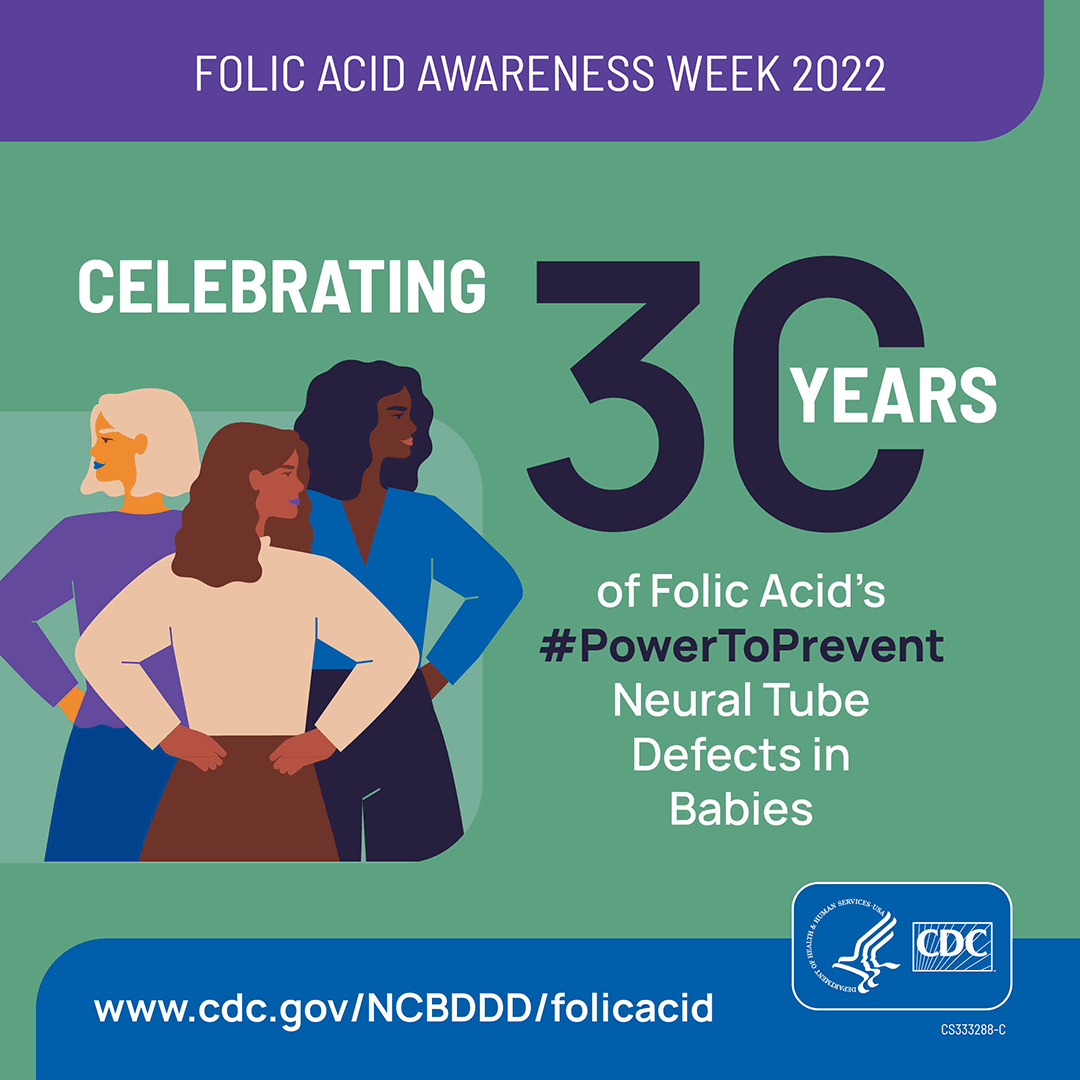Folic Acid: The Best Tool to Prevent Neural Tube Defects
Learn how to get healthy before and during early pregnancy to increase your chance of having a healthy baby. Plan ahead by getting 400 micrograms (mcg) of folic acid daily.

CDC celebrates 30 years of folic acid’s power to prevent neural tube defects. For three decades, the US Public Health Service has recommended that all people capable of becoming pregnant consume 400 micrograms (mcg) of folic acid daily to prevent neural tube defects (NTDs). Folic acid is an important part of planning for a healthy pregnancy. The two most common types of neural tube defects are anencephaly and spina bifida. Anencephaly is a serious birth defect in which parts of a baby’s brain and skull do not form correctly. Almost all babies born with anencephaly will die shortly after birth. Spina bifida is a serious birth defect in which a baby’s spine does not form correctly and can result in some severe physical disabilities. All people who are capable of becoming pregnant should get 400 mcg of folic acid every day.
Do I need folic acid?
Yes! Anyone who can become pregnant should get 400 mcg of folic acid daily, in addition to eating foods with folate from a varied diet, even if they do not plan on becoming pregnant. Our bodies use folic acid to make new cells like skin, hair, and nails. Start a healthy habit today by getting 400 mcg of folic acid every day.
Why should I start taking folic acid now?

All people who are capable of becoming pregnant should get 400 micrograms (mcg) of folic acid every day.
Neural tube defects (like anencephaly and spina bifida) happen in the first few weeks of pregnancy, often before a person finds out they are pregnant. Also, almost half of all pregnancies in the United States are unintended. This is why it is important for all people who can become pregnant to get 400 mcg of folic acid every day, even if they are not planning a pregnancy. By the time a person realizes they are pregnant, it might be too late to prevent these birth defects. Plan ahead! Starting today is the best option.
How do I get folic acid?
An easy way to be sure you’re getting enough folic acid is to take a daily vitamin with 400 mcg of folic acid in it (most vitamins contain the recommended daily amount of 400 mcg of folic acid). If taking a vitamin upsets your stomach, try taking it with food or just before bed. If you have trouble taking pills, try a chewable vitamin. Also, be sure to take it with a full glass of water.

Folic acid is added to foods such as enriched breads, pastas, rice, cereals, and some corn masa flour. Corn masa flour is used to make foods such as corn chips, tortillas, tamales, and taco shells. Check the nutrition label on the food packaging to see if it has folic acid.
You can also eat a diet rich in folate. Folate can be found in foods like beans, peas, and lentils; oranges and orange juice; asparagus and broccoli; and dark leafy green vegetables such as spinach and mustard greens. But it can be hard for most women to get the recommended daily amount of folate through food alone.
Taking a supplement with more than 400 mcg of folic acid each day is not necessarily better for preventing a neural tube defect. Only do so if a doctor recommends taking more per day due to other health conditions.
Resources for Healthcare Professionals
CDC has English- and Spanish-language folic acid educational materials for healthcare professionals that can be downloaded or ordered for free. Visit our folic acid partner toolkit today to get your educational materials!
Article of Interest
Folic Acid and the Prevention of Birth Defects: 30 Years of Opportunity and Controversies For three decades, the US Public Health Service has recommended that all persons capable of becoming pregnant consume 400 μg/day of folic acid (FA) to prevent neural tube defects (NTDs). This review describes the status of FA fortification, including the countries that fortify (n = 70) and at what level (100–220 µg per 100 g of product), and the research describing the impact of those programs on NTD rates (up to 78% reduction), blood folate concentrations [red blood cell folate concentrations increased ~1.47-fold (95% CI, 1.27, 1.70) following fortification], and other health outcomes. (Published August 2022)